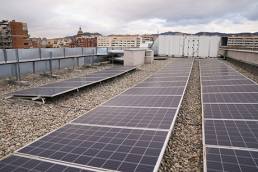The second phase of the “Pla Clima Escola Barcelona”, a project focused on improving the climate resilience and energy efficiency of schools in Barcelona, has begun. This second phase includes the air conditioning of 30 new schools with an investment of 17.7 million euros, financed by the tourist tax. The work will be carried out throughout 2025, adding to the 24 air-conditioned centers, benefiting 17,774 students.
The project is an ambitious initiative of the Barcelona City Council that aims to boost the indoor quality of teaching spaces, ensuring the most appropriate conditions for students’ cognitive development, while improving the sustainability and decarbonization of public schools. To do so, the City Council intends to install mechanical ventilation systems (controlled by CO₂ sensors) to ensure indoor air quality, which will work with aerothermal heat pump systems in 170 educational centers in the city by 2029. The use of heat pumps enables the electrification of heating systems, which currently consume natural gas, and thus facilitate the step towards the decarbonization of the centers.
These new air conditioning systems will be achieved from the energy generated by 30,000 m² of photovoltaic panels that will be installed on the roofs of participating centers and public spaces to feed the so-called “school energy communities”, to reduce CO₂ emissions and promote energy self-sufficiency.
Aiguasol’s expertise in the project.
Aiguasol has played a key role in this project, developing a methodology to map the needs, i.e. the cooling and heating thermal powers and demands of all primary schools in the city. Once the needs were detected, the analysis and selection of the most appropriate technologies in each case was also developed, considering the characteristics and location of each center, to guarantee thermal comfort and improve energy efficiency.
Therefore, we have acted following a sequential intervention process in four complementary levels, even though the Energy Improvement Plan only reached level three:
- Level 1. Basic mitigating measures, e.g. sun shading, proper management of equipment, installation of water points, etc.
- Level 2. Passive systems, e.g. installation of vinyls, thermal insulation of roofs and facades, favoring natural cross-ventilation, etc.
- Level 3. Low impact active systems, such as the installation of various types of fans, spot air conditioning of spaces, etc.
- Level 4. Active renewable systems and *domotitzats, which include integral installations of natural air conditioning with renewable energies and with progressive and regulated intensity with *sensorització and telecontrol.
Decarbonization: reducing carbon footprint
With the new air conditioning and ventilation systems, as well as the use of photovoltaic panels, Barcelona’s public schools not only contribute to the reduction of the carbon footprint but also improve the comfort of their classrooms (comfort understood as thermal comfort and air quality). The installation of aerothermal systems allows optimal regulation of heat and cold, and the air renewal devices ensure the correct indoor air quality of the spaces according to the requirements of the HS-3 CTA code.
Currently, 24 schools are actively participating in this climate mitigation initiative, contributing to the thermal comfort of study spaces and facilitating the proper development of the cognitive skills of more than 8,300 students.
Schools as key players in driving the energy transition
The installation of solar panels allows schools to take an active role in the generation of renewable energy for their own consumption and share the surplus with the public power grid. This self-sufficiency model helps to reduce dependence on non-renewable energy sources and to turn these centers into actors of change to drive the transition to a more collaborative and low-carbon economy.
The decision of the Barcelona City Council to promote the “Pla Clima Escola” is a firm step towards the decarbonization of educational centers and a firm commitment to renewable energies, placing the city at the forefront of the energy transition and committed to a more sustainable future for new generations.
We hope that their case will serve as a reference to other cities to implement technologies that not only reduce the environmental impact of educational facilities but also make it possible to create healthier spaces for students.


